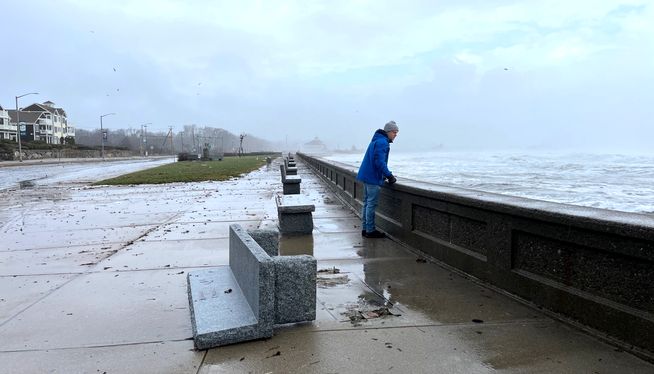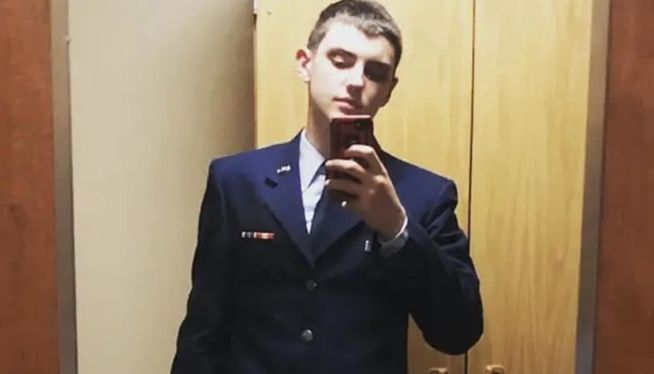
MISSION, Kan. (AP) — Tens of millions of Americans endured bone-chilling temperatures, blizzard conditions, power outages and canceled holiday gatherings Friday from a winter storm that forecasters said was nearly unprecedented in its scope, exposing about 60% of the U.S. population to some sort of winter weather advisory or warning.
In Rhode Island, the storm caused widespread street and coastal flooding, thousands of people were left without power due to power lines downed by high winds, ferry service to Block Island was cancelled and restrictions were imposed on larger vehicles traveling over bridges.
More than 200 million people were under an advisory or warning on Friday, the National Weather Service said. The weather service’s map “depicts one of the greatest extents of winter weather warnings and advisories ever,” forecasters said.
Power outages have left more than 1.4 million homes and businesses in the dark, according to the website PowerOutage, which tracks utility reports.
And more than 4,100 flights within, into or out of the U.S. were canceled Friday, according to the tracking site FlightAware, causing more mayhem as travelers try to make it home for the holidays. Some airports, including Seattle-Tacoma International Airport, closed runways.
The huge storm stretched from border to border. In Canada, WestJet canceled all flights Friday at Toronto Pearson International Airport, beginning at 9 a.m. And in Mexico, migrants waited near the U.S. border in unusually cold temperatures as they awaited a U.S. Supreme Court decision on whether and when to lift pandemic-era restrictions that prevent many from seeking asylum.
Forecasters said a bomb cyclone — when atmospheric pressure drops very quickly in a strong storm — had developed near the Great Lakes, stirring up blizzard conditions, including heavy winds and snow.
“The impacts are perhaps far greater than they might be in the middle of winter during a typical weekend without a holiday,” said Greg Carbin, chief of forecast operations for the Weather Prediction Center at the National Weather Service, noting that while the blizzard conditions and Arctic air may set some records, the storm isn’t unprecedented.
Even though fleets of snow plows and salt trucks have been deployed, driving was hazardous and sometimes deadly. A Kansas City, Missouri, driver died Thursday after skidding into a creek. And in the Chicago suburb of Des Plaines, a pickup truck driver was hospitalized after sliding into a pond.
State police in Michigan said in tweets that nine tractor-trailers crashed on Interstate 94 in Berrien County in the western part of the state.
Activists also were rushing to get the homeless out of the cold. Nearly 170 adults and children were keeping warm early Friday in Detroit at a shelter and a warming center that are designed to hold 100 people.
“This is a lot of extra people” but “you can’t” turn anyone away, said Faith Fowler, the executive director of Cass Community Social Services, which runs both facilities.
In Chicago, Andy Robledo planned to spend the day organizing efforts to check on unhoused people through his nonprofit, Feeding People Through Plants. Robledo and volunteers build tents modeled on ice-fishing tents, including a plywood subfloor.
“It’s not a house, it’s not an apartment, it’s not a hotel room. But it’s a huge step up from what they had before,” Robledo said.
In Portland, Oregon, officials opened five emergency shelters. Fallen trees and power lines have closed roads across the Portland metro area. And nearly 50 miles (80 kilometers) of Interstate 84, a major highway through the Columbia River Gorge, were closed Friday morning.
All bus service was suspended in the greater Seattle area Friday morning due to an ice storm that made travel treacherous.
In far northern Indiana, lake-effect snow rolling off Lake Michigan could boost storm totals to well over a foot in some areas by Sunday, said Mark Steinwedel, a meteorologist with the National Weather Service in Syracuse, Indiana.
“It’s really going to add up,” he said, predicting “pretty awful travel.”
The weather service is forecasting the coldest Christmas in more than two decades in Philadelphia, where school officials shifted classes online Friday.
In South Dakota, Gov. Kristi Noem late Thursday activated the state’s National Guard to haul firewood from the Black Hills Forest Service to the Rosebud Sioux Tribe as some members were stranded in their homes with dwindling fuel.
Other tribes also were struggling, including the Oglala Sioux Tribe in the western part of the state, which was using snowmobiles to reach members who live at the end of miles-long dirt roads.
But with the vehicles breaking down in the 10-foot drifts, officials were considering using horses to deliver essentials to some homes. Tribal officials have reached out to the Federal Emergency Management Agency for help.
“It’s been one heck of a fight so far,” said tribal President Frank Star Comes Out.
In Maine, gusts approaching 70 mph were reported along the coast Friday morning. Atop New Hampshire’s Mount Washington, the tallest peak in the Northeast, the wind topped 130 mph (210 kph). The governor closed state offices, ferry service to Casco Bay islands was suspended and flooding was leading to some water rescues.
The cold was putting a strain on utilities. The nation’s largest public utility asked businesses and the public in a tweet to reduce usage as much as possible without sacrificing safety. The Tennessee Valley Authority, which provides electricity to 10 million people in Tennessee and parts of the surrounding states of Alabama, Mississippi, Kentucky, Georgia, North Carolina and Virginia, also warned that there may be brief, intermittent power outages.
It was so bad in Vermont that Amtrak canceled service for the day, and nonessential state offices were closing early.
“I’m hearing from crews who are seeing grown trees ripped out by the roots,” Mari McClure, president of Green Mountain Power, the state’s largest utility, said at a news conference.
In eastern Iowa, sports broadcaster Mark Woodley became a Twitter sensation after he was called on to do live stand ups in the wind and snow because sporting events were called off. By midday Friday, a compilation of his TV stand-ups had been viewed nearly 5 million times on Twitter.
“I’ve got good news and I’ve got bad news,” he told an anchor. “The good news is that I can still feel my face right now. The bad news is, I kind of wish I couldn’t.”












